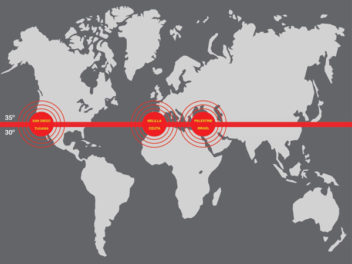
Abandoned Dust Bowl Home, about 1935–1940, Dorothea Lange. Gelatin silver print, 7 7/16 × 9 5/8 in. The J. Paul Getty Museum, Los Angeles, 2000.50.12. Digital image courtesy of the Getty’s Open Content Program
What does art have to do with the environment? Right now scholars visiting the Getty Research Institute are digging deep into the complex intersection of art and ecology, which is this year’s theme for the Getty Research Institute’s Scholars Program.
On the occasion of Earth Day—and while staying at home—three of the current Getty Scholars in Residence checked in with each other about this annual event and shared some of the more surprising insights into environmental history that they have uncovered in their research.
James Nisbet discusses the first Earth Day and environmental art of the 1960s and ‘70s. Michaela Rife looks at 1930s Post Office murals in relation to the Dust Bowl and Grace Kim asks us to consider if micro-organisms belong on cultural heritage.
James Nisbet: Grace and Michaela, thanks for joining me. Earth Day has held something of a slippery place in my research. I published a book a few years ago about American environmental art and politics in the 1960s and 1970s. Since the first Earth Day landed right in the middle of those decades—in 1970—it would seem to be a pivotal event. In many ways, it was in bringing together millions of people in recognition of the importance of environmental protections and in protest of US policies degrading the quality of air, water, and land.
Earth Day’s gathering and mobilization of people has continued to be vital to the cause of environmental protest. But at the same time, in focusing on highly visible recent events like the Santa Barbara Oil Spill of 1969, the conversations around the first Earth Day tended to overlook more underlying, systemic issues holding back environmental reform, such as the scientific belief that the Earth had a natural balance that would be simply restored if and when pollutants were curtailed.
Michaela Rife: That’s interesting that you bring up that overlooked aspect of Earth Day. My research considers murals installed in US post offices in the 1930s, during an earlier period of environmental “disaster.” These murals offered an income for artists and a bright spot for communities during the Great Depression. However, I ask if we can see the impact of the concurrent Dust Bowl in these artworks, even though there are no scenes of drought or dust storms. For example, did suffering towns request pleasant landscapes as a means of envisioning a different world? Murals of agricultural abundance stood in stark contrast to photographs like Dorothea Lange’s bleak scene of an abandoned Dust Bowl home, in the Getty’s collection.
Visible “disasters” like an oil spill or a drought can often spur visual campaigns and prompt artistic documentation, but as humanities researchers, we have to ask what assumptions are perpetuated in these works. By asking these questions, I hope to understand how the environment influences artistic production, beyond the representational.

Microbial growth on a mausoleum at the Monumental Cemetery of Milan in Milan, Italy
Grace Kim: These are really great examples of how different ideas of “environment” do different things in the world—from spurring collective action to providing a distracting fantasy. As a cultural anthropologist, I consider how scientific research on the environment is shaping the practices of art and cultural heritage conservation. Specifically, my research at the Getty focuses on how scientists in the US and Italy today understand the communities of micro-organisms that settle on the surfaces of heritage. Working together with conservators, these scientists use new ecological frameworks to tackle the question of whether or not micro-organisms belong on heritage, and whether or not they should be removed.
I am interested in not only how the definition of a cultural artifact’s “authenticity” is shifting as a result, but also how this transformation goes hand in hand with changing interpretations about what counts as “the environment.” Humanities research can help track these interpretations and their particular effects in society. For example, historian Kate Brown has pointed out in The New Yorker that the SARS-CoV-2 pandemic is not a random natural disaster, but an ecological one made possible by processes of urbanization, industrialization, and globalization that have been ongoing since the early nineteenth century.
MR: I think you both bring up that one of the problems with an event like Earth Day, or with understanding our current pandemic, is seeing “nature” as something apart from the human. For me, researching art from an environmental angle means thinking about all of the ways that those divisions are messy. For example, settlers in the Dust Bowl understood that they had damaged the Great Plains through over plowing, but it is also a mistake to describe the region as an “untouched wilderness” prior to Euro-American settlement. Native peoples shaped (and continue to shape) the environment through their own land-use practices, including fire, crop cultivation, and hunting. Today, there are a lot of media stories about how “nature” is responding to the pandemic, from cleaner air here in Los Angeles to fish in Venice. Yet that would seem to reinforce the earlier conception of the first Earth Day that the earth has a natural balance.
JN: I’ve also been thinking about the duration of environments over time in the course of my research this year. One example is a permanent outdoor artwork in New York called Time Landscape. Planted in 1978 on a city block in the West Village, the artist who made the piece meant for it to demonstrate three stages of growth in the forest that existed on the island of Manhattan prior to Dutch colonial contact. It has since been absorbed by New York’s Greenstreet urban reclamation program. What interests me about Time Landscape are the many layers of it that exceed the idea of the landscape’s naturalness or timelessness.
Because the disruption of colonial settlement can’t just be rolled back by planting trees. Nor is it even possible for trees and undergrowth to develop today in New York City as they would have prior to the 1700s. Climate and concrete and the actual people who live there all affect the appearance of its landscapes over time. To me, this doesn’t transport us into the past, so much as reveal the degree to which the experience of an environment extends beyond the singular vision of any one person.
GK: Conservators know how difficult it is to make things last—environment or art. In my research, I have found that scientists who want to develop technologies for art restoration must also navigate conservators’ complex judgments about how “the original” should be restored. These judgments are informed by cultural values regarding cleanliness and contamination, for instance, that depend on who you are talking to as well as when and where you are talking to them. Does microbial growth on a mausoleum in a cemetery count as deterioration, or is it a biological patina that signifies the artifact’s specific historicity and place?
As Jamie has said, there are multiple layers of meaning to excavate, and much expertise and work is necessary to answer this question alone. Correspondingly, acknowledging the “slippery” and “messy” aspects of deciding what the environment should look like seems a challenging, yet necessary, component of environmentalism. As Michaela has reminded us, humanities scholarship can demonstrate how images of a “pristine nature” make some politics more visible than others, and how issues of social justice and environmental justice are entangled in one another.
Grace Kim received her PhD in History, Anthropology, and Science, Technology, and Society at the Massachusetts Institute of Technology, Cambridge. Her research focuses on the anthropology of art and science, and her research project is titled Cultures on Culture: Biofilm, Conservation, and the Interface of Art and Environment.
James Nisbet is Associate Professor of Art History at the University of California, Irvine. His research centers on modern and contemporary art and theory with an emphasis on environmental history and the history of photography. His project is Ecology against Modernism: Visual Media and the Vitality of Knowledge in the Transatlantic Nineteenth Century.
Michaela Rife is a PhD candidate in the Department of History of Art at the University of Toronto, Canada working on her project Public Art, Private Land: Settler Colonialism, Art and Land Use on the Great Plains.




Comments on this post are now closed.